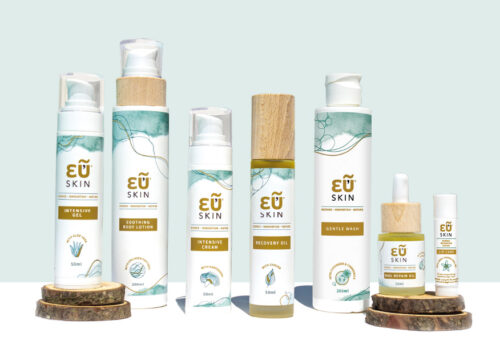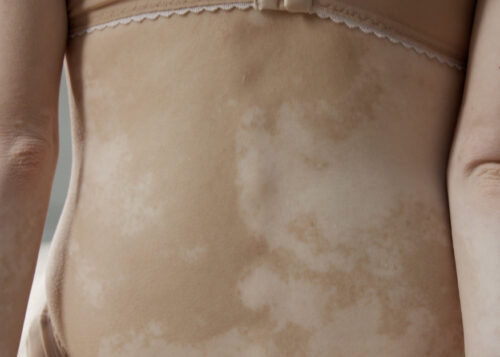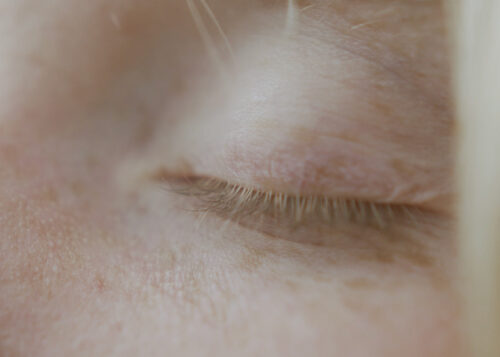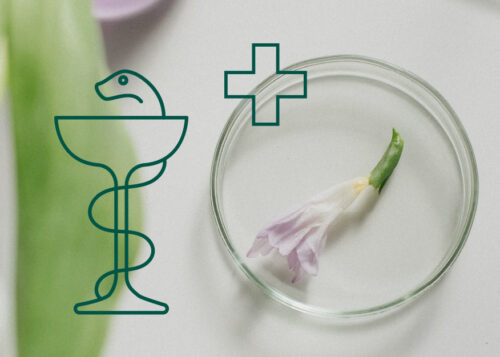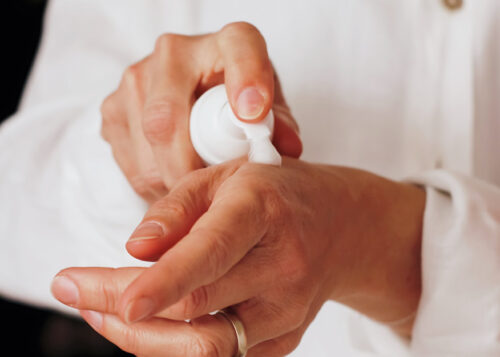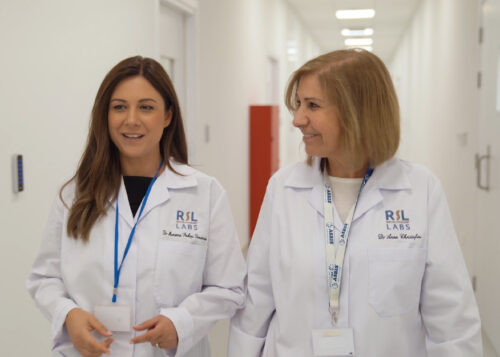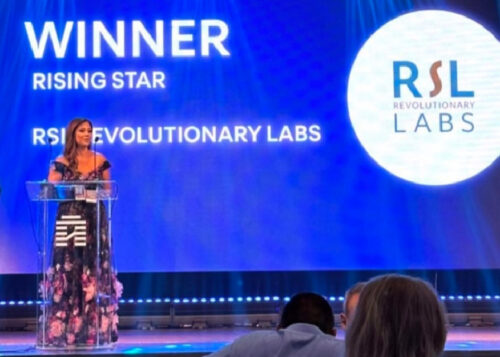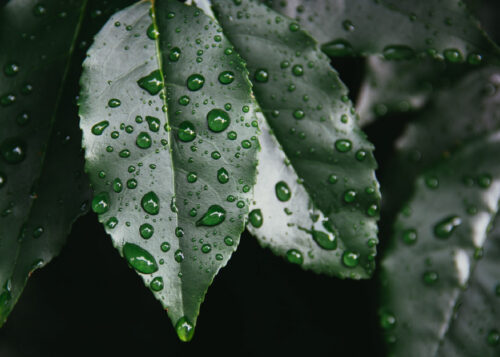Ingredients
The choice of every bioactive component for our products has been made meticulously, with a thorough consideration of scientific evidence.
Below you can read more information on our ingredients.
The organoprotective agent
The organoprotective agent
Gynura procumbens
source of natural antioxidants
(phenolic compounds)
Due to its high phenolic content, it protects the skin from free radicals and environmental aggressors1.
Gynura procumbens is a medicinal plant commonly found in tropical Asia. It is known for its antibacterial, antifungal, anti photoaging and antioxidant abilities. Antioxidants are known for their protective effect on the skin as they protect it from oxidative damage. Researches have shown that due to the high percentage of phenolic compounds found in Gynura procumbens, it exhibits natural antioxidant activity1, therefore making it a powerful natural antioxidant for the skin. Previous studies have shown that UV irradiation induces degradation of colla gen in the skin2. Researches have shown that properties of Gynura procumbens inhibit the expression of the proteins responsible for the degradation of collagen induced by UV irradiation3.
The scaffold of skin tissue
The scaffold of skin tissue
Collagen peptides
rich in Gly-Pro-Hyp
(amino acids)
Collagen has been shown to improve healing chronic wounds in randomised clinical trials4.
Collagen is the unique, triple helix protein molecule, which forms the major part of the extracellular dermal matrix (ECM) of the dermis in the skin. Together with the glycosaminoglycans, proteoglycans, laminin, fibronectin, elastin and cellular components are responsible for fibroblast migration, survival and metabolism5. Collagen type I, II and III acts as a scaffold in connective tissue that is deposited early in wound healing by the fibroblasts to help with the wound healing progress6-7. Marine derived collagen I has been previously shown to promote wound healing in wound models and clinical studies8-10.
The resilience agent
The resilience agent
Ganoderma lucidum
excellent anti-inflammatory
(triterpenes)
Ganoderma lucidum has been shown to potentially inhibit inflammatory skin conditions and promote keratinocyte proliferation11.
Ganoderma lucidum has numerous pharmacological and therapeutic properties that make it an excellent antiallergic, antioxidant, antitumor, antiviral, and antiinflammatory ingredient12. Terpenoids and polysaccharides in Ganoderma, are being extensively studied for their antimicrobial properties on skin as it has been shown that they act on the bacterial cytoplasmic membranes13. Polysaccharides isolated from Ganoderma show an antioxidant activity and protect tissues from reactive oxygen species toxicity14. In addition, extracts of Ganoderma show anti inflammatory activity as it has been shown to suppress cytokines responsible for inflammation such as IL-615.
The nourishing agent
The nourishing agent
Aloe vera
rich in vitamins and minerals
(glucomannan)
Glucomannan has demonstrated anti-inflammatory, tissue regeneration acceleration, and antibacterial properties16.
Aloe vera has been used for centuries to treat skin injuries such as burns and eczemas because of its anti-inflammatory17, antimicrobial18 and wound healing properties19. The active ingredients found in the aloe vera leaf extract consist of tocopherols, organic acids, fatty acids, sugars – mannan, and phenolic compounds. Even though polysaccharides are the main constituent of aloe vera it was shown that the biological activity of aloe vera are a result of a synergistic action of a variety of compounds16. In a clinical study performed on 60 Head and Neck cancer patients undergoing radiotherapy as a treatment it was shown that aloe vera delayed radiation induced dermatitis20.
The reservoir of growth factors
The reservoir of growth factors
Hyaluronic acid
excellent moisturising abilities
(hyaluronic acid)
Hyaluronic acid has been shown to reduce the surface area of the wound by 70%21.
Hyaluronic acid is a natural polysaccharide and a key component of the extracellular matrix and is known to be involved in several mechanisms of the wound healing process such as decreasing inflammation, regulating tissue remodeling and enhancing angiogenesis22. Skin aging, both intrinsic and extrinsic (ie. by UV irradiation), is associated with loss of moisture in the skin. One key molecule responsible for maintaining the moisture in the skin is hyaluronic acid with its unique ability to bind and retain water molecules23, thus it plays a vital role in skin aging.
In a clinical trial studying wound healing in acute wounds of patients, it has been shown that hyaluronic acid was able to help decrease the wound by 70% in size, 10 days after application21. In 2012, a systematic review was published, which collected clinical trials on the usefulness of hyaluronic acid derivatives in the treatment of a wide variety of wounds: burns (including radiodermatitis), superficial surgical wounds (dermabrasion) and chronic wounds (venous ulcers and diabetic foot)24.
The infection fighter
The infection fighter
Cannabis seed oil
rich in cannabidiol
(cannabidiol)
A valuable source of biologically active substances that reduce oxidative stress, inhibit skin aging processes and positively affect the viability of skin cells25.
Cannabinoids and endocannabinoids are pharmacologically active ingredients produced by cannabis sativa. Humans have an endocannabinoid system that is used to regulate several processes i.e. the production of proteins26. Over 200 terpenoids are identified in C.sativa, and those are associated with medicinal properties such as antimicrobial, antioxidant and anti-inflamatory amongst other27.Cannabis sativa seed extract impedes the mediators of inflammation that occur during wound healing28. Cannabis sativa extract, also known as hemp extract is a valuable source of biologically active substances that reduce oxidative stress, inhibit skin aging processes and positively affect the viability of skin cells25.
The natural skin protector
The natural skin protector
Grapeseed oil
excellent antioxidant properties
(gallic acid)
Its antioxidant properties may be beneficial to protect the skin against radiation-induced free radicals29.
Grapeseed extract has a high composition of proanthocyanidins that have the ability to trigger the release of vascular endothelial growth factor and therefore a topical application can cause wound contraction and closure faster than the normal rate. The effect on skin lesions of the topical application of the grape seed extract increased cell density and the deposition of connective tissue at the wound30. Grape seed extract has proven anti-inflammatory and antimicrobial properties are due to high content of polyphenols, proanthocyanidins and resveratrol31. Polyphenolic compounds found in grape seed extract, specifically catechin and epicatechin, it is due to those compounds that the cell viability was increased and as a result protected the cells from UVA damage32.
The skin barrier restorer
The skin barrier restorer
Panthenol
excellent moisturising abilities
(pantothenic acid)
Panthenol, improves hydration in the upper layers of the skin and prevents transepidermal water loss33.
Panthenol is very important in normal epithelial function. When applied topically, it is readily absorbed and rapidly converted enzymatically to pantothenic acid, a constituent of coenzyme A3. It acts as a moisturiser by improving hydration in the upper layers of the skin and preventing transepidermal water loss but it has also been shown to be involved in wound healing33. As a result, panthenol has been extensively studied both for its skin moisturising/restoring abilities and for its beneficial effects in wound healing. A research group studying the effect of dexpanthenol on the skin barrier, has shown that treatment for 7 days has improved epidermal hydration and reduced transepidermal water loss34.
Another clinical study focused on the efficacy of dexpanthenol in protecting skin against irritation. Their results suggest that dexpanthenol is able to protect the skin by preserving the hydration levels in the epidermis even in the presence of an irritant agent35. The effectiveness of dexpanthenol in wound healing has been shown by different studies, one of which focused on the topical application of dexpanthenol in in vivo models of minor skin trauma, which showed a significantly faster wound healing36. Stettler et al, researched the effects of dexpanthenol in an anti scar gel in hypertrophic scars. Their results show that after 8 weeks the scars were significantly less vascularized, less pigmented, softer, thinner, flattened and more elastic37.
The barrier booster
The barrier booster
Sweet orange peel oil
excellent tissue-repair properties
(perillyl alcohol – POH)
POH demonstrates significant anti-inflammatory effects in dermal inflammation and wound healing experiments38.
Orange peel extracts main constituent is polymethoxyflavonoid (PMFs) which have shown to protect the skin against UV damage39. Citrus peel extracts have been used for their antioxidant and anti-inflammatory properties40. Dominant compound of the peel oil are monoterpene hydrocarbons specifically limonene41. D-Limonene and its metabolite perillyl alcohol contributes significantly as an anti-inflammatory agent in murine dermal inflammation and wound-healing. D-limonene, amongst other activities assisting the wound healing process, decreases the cytokine production contributing to the reconstruction of the epidermal barrier38.
The repairing factor
The repairing factor
Balsam oil
rich in naphthoquinones
(naphthoquinones)
Naphthoquinones found in Balsam oil possess remarkable wound healing and anti-inflammatory activities42.
Hypericum perforatum has been used both orally and topically for healing wounds and burns probably due to its antioxidant, antimicrobial and anti inflammatory properties43. A clinical study showed that topical application of the extract on cesarean sections promoted healing and epithelial reconstruction44. Another clinical study has shown an increase in hydration and a reduction in transepidermal water loss when hypericum was applied topically in comparison to the control group44. In addition, St John’s Wort has been shown to aid with wound healing of burn wounds. When applied topically, it aided acceleration of healing of second and third degree burn wounds 3 times faster than conventional methods45.
The remodeling factor
The remodeling factor
Calendula officinalis
excellent anti-inflammatory
(xanthophyll)
Xanthophyll has a role in treating minor inflammation of the skin and assisting the healing process of minor wounds46.
Calendula officinalis flower extract has been widely used for the treatment of minor wounds, and it has been approved by the European Medicine Agency to be used in products that aim to reduce inflammation in the skin. In a study using scratch assays, it has been shown that Calendula had an effect on the inflammatory phase of wound healing by activating a pathway that increases IL-8 in the keratinocytes thus increasing wound closure47. Preethi et al, has found that when the calendula extract was used in an in vivo wound healing model, it led to reduced proinflammatory markers and reduced edema48. Calendula also improves distensibility, firmness and viscoelasticity in the skin49.
The nourish booster
The nourish booster
Shea butter
excellent source of fatty acids
(fatty acids)
Fatty acids are the main component of shea butter that play a role in its antioxidant and anti-inflammatory properties50-52.
Shea butter is the solid fat extracted from mature fruits of the sheu tree (Vitellaria paradoxa). 90% of its constituents are triglycerdes and 10% non-triglycerides such as oil soluble tocopherols, triterpenes, phenols, allantoin, polyphenols and karitene. Shea butter is a rich source of fatty acid, more common to found stearic, oleic, palmitic, linoleic and arachidic53.Topical use of Shea butter has shown anti-aging and anti-inflammatory properties54. The anti-inflammatory properties of shea butter were proved by the inhibition of iNOS, COX-2 and cytokines55.
The revive factor
The revive factor
Cucumber extract
excellent antioxidant properties
(vitamin C)
Rich in Vitamin C, it stimulates collagen synthesis and assists in antioxidant protection and photodamage56.
Cucumis sativus extract has shown antioxidant and analgesic activity. Compounds found in the extract responsible for those activities are flavonoids and tannins57. The extract is also rich in vitamin C which stimulates collagen synthesis and assists in antioxidant protection and photodamage58-59. Cucumber is used not only for its soothing effects on skin irritation but also reduces swelling. Cucumis sativus extracts have shown pharmacological activities such as antioxidant, antiwrinkle and antiaging and antimicrobial. Lactic acid an ingredient found in cucumber juice is used for dry skin, ichthyosis56. A topical skin care cream produced with cucumber extract was proven to increase trans-epidermal water loss and acts as a whitening agent60.
The calming agent
The calming agent
Chamomile extract
rich in bisaboloids
(a-bisabolol molecule)
Has a role in faster reepithelialisation and wound-breaking strength61.
Chamomile, a medicinal plant, contains levomenol, bisaboloids, chamazulene, and flavonoids, which are responsible for its anti inflammatory and antimicrobial properties62. It has been shown that when it is applied topically as a gel, it delays the onset of radiation dermatitis in a study conducted with head and neck cancer patients undergoing radiotherapy63. Another study by Nayak et al has shown that when chamomile extract was applied topically on the wound, it was able to reepithelialise faster and had a significantly higher wound-breaking strength in comparison to the control group61.
The tranquil factor
The tranquil factor
Lavender essential oil
rich in monoterpenes
(linalool molecule)
Due to its high monoterpene content, it has anti-bacterial and anti-fungal properties64.
Lavender oil owes its anti-bacterial and anti-fungal activity to its main components monoterpenes such as linalool and linalyl acetate64. It was shown in a study performed on rat models that topical application of lavender oil increased collagen synthesis by fibroblasts65. It was proven that lavender essential oil is an inhibitor of the synthesis of 4 pro-inflammatory cytokines characterizing the oil for anti-inflammatory treatment66.
- Rosidah, Y. M. et al. (2008). ‘Antioxidant potential of Gynura procumbens’, Pharmaceutical Biology, 46(9), 616–625.
- Rittié, L., & Fisher, G. J. (2002). UV-light-induced signal cascades and skin aging. Ageing research reviews, 1(4), 705–720.
- Kim, J., Lee, C. W., Kim, E. K., Lee, S. J., Park, N. H., Kim, H. S., Kim, H. K., Char, K., Jang, Y. P., & Kim, J. W. (2011). Inhibition effect of Gynura procumbens extract on UV-B-induced matrix-metalloproteinase expression in human dermal fibroblasts. Journal of ethnopharmacology, 137(1), 427–433.
- Yonath, A., & Traub, W. (1969). ‘Polymers of tripeptides as collagen models. IV. Structure analysis of poly(L-proly-glycyl-L-proline)’, Journal of molecular biology, 43(3), 461–477.
- Tracy, L. E., Minasian, R. A., & Caterson, E. J. (2016). Extracellular Matrix and Dermal Fibroblast Function in the Healing Wound. Advances in wound care, 5(3), 119–136.
- Desmouliere A, Redard M, Darby I, Gabbiani G (1995) Apoptosis mediates the decrease in cellularity during transition between granulation tissue and scar. Am J Pathol 146: 56–66.
- Berry DP, Harding KG, Stanton MR, et al (1998) Human wound contraction: collagen organisation, fibroblasts and myofibroblasts. Plast Reconstr Surg 102: 124–31.
- Baldursson B.T., Kjartansson H., Konrádsdóttir F., Gudnason P., Sigurjonsson G.F., Lund S.H. Healing rate and autoimmune safety of full-thickness wounds treated with fish skin acellular dermal matrix versus porcine small-intestine submucosa: A noninferiority study. Int. J. Low. Extrem. Wounds. 2015;14:37–43.
- Badois N., Bauër P., Cheron M., Hoffmann C., Nicodeme M., Choussy O., Lesnik M., Poitrine F.C., Fromantin I. Acellular fish skin matrix on thin-skin graft donor sites: A preliminary study. J. Wound Care. 2019;28:624–628.
- Woodrow T., Chant T., Chant H. Treatment of diabetic foot wounds with acellular fish skin graft rich in omega-3: A prospective evaluation. J. Wound Care. 2019;28:76–80.
- Abate, M., et al.(2020). ‘Ganoderma lucidum Ethanol Extracts Enhance Re-Epithelialization and Prevent Keratinocytes from Free-Radical Injury’ Pharmaceuticals (Basel, Switzerland), 13(9), 224.
- Quereshi S., Pandey A. K., Sandhu S. S. (2010). Evaluation of antibacterial activity of different Ganoderma lucidum extracts. J. Scientific Research Vol 3(1).
- Cör Andrejč, D., Knez, Ž., & Knez Marevci, M. (2022). Antioxidant, antibacterial, antitumor, antifungal, antiviral, anti-inflammatory, and nevro-protective activity of Ganoderma lucidum: An overview. Frontiers in pharmacology, 13, 934982.
- Jeong Y. U., Park Y. J. (2020). Ergosterol peroxide from the medicinal mushroom ganoderma lucidum inhibits differentiation and lipid accumulation of 3T3-L1 adipocytes. Int. J. Mol. Sci. 21, 460.
- Dudhgaonkar S., Thyagarajan A., Sliva D. (2009). Suppression of the inflammatory response by triterpenes isolated from the mushroom Ganoderma lucidum. Int. Immunopharmacol. 9, 1272–1280. 10.1016/j.intimp.2009.07.011
- Rahman, S., et al. (2017), ‘Aloe Vera for Tissue Engineering Applications’, J Funct Biomater., 8(1):6.
- Vasquez, B. (1996). ‘Antiinflammatory activity of extracts from Aloe vera gel.’ Journal of Ethnopharmacology, 55(1) p 69-75.
- Habeeb, F.(2007). ‘Screening meethods used to determine the anti-microbial properties of aloe vera inner gel’. Methods 42 (4), p315-320.
- Sanchez, M.(2020). ‘Pharmacological update properties of Aloe vera and its major active constituents.’ Molecules, 25(6) p 1324.
- Rao, S. (2017). ‘An Aloe Vera-Based cosmeceutical cream delays and mitigates ionizing radiation-induced dermatitis in head and neck cancer patients undergoing curative radiotherapy: A clinical study’ Medicines 4, 44.
- Voinchet, V. et al. (2006). ‘Efficacy and safety of hyaluronic acid in the management of acute wounds’, American journal of clinical dermatology, 7(6), 353–357.
- Cortes, H., Caballero-Florán, I. H., Mendoza-Muñoz, N., Córdova-Villanueva, E. N., Escutia-Guadarrama, L., Figueroa-González, G., Reyes-Hernández, O. D., González-Del Carmen, M., Varela-Cardoso, M., Magaña, J. J., Florán, B., Del Prado-Audelo, M. L., & Leyva-Gómez, G. (2020). Hyaluronic acid in wound dressings. Cellular and molecular biology (Noisy-le-Grand, France), 66(4), 191–198.
- Papakonstantinou, E., Roth, M., & Karakiulakis, G. (2012). Hyaluronic acid: A key molecule in skin aging. Dermato-endocrinology, 4(3), 253–258.
- Voigt J, Driver VR. (2012) Hyaluronic acid derivatives and their healing effect on burns, epithelial surgical wounds, and chronic wounds: a systematic review and meta-analysis of randomized controlled trials. Wound Repair Regen. 20(3):317-31.
- Zagorska-Dziok, M., et al. (2021). ‘Positive effect of Cannabis sativa L, Herb extracts on skin cells and assessment of cannabinoid-based hydrogel properties.’ Molecules, 26(4), 802.
- Martins, A, M et al (2022), ‘Cannabis-based products for the treatment of skin inflammatory diseases: a timely review’. Pharmaceuticals (Basel) 15(2):210.
- Nuutinen T. (2018) ‘Medicinal properties of terpenes found in Cannabis sativa and Humulus lupulus.’ Eur. J. Med. Chem. 157:198–228.
- Sangiovani, E et al (2019) ‘Cannabis sativa L. extract and cannabidiol inhibit in vitro mediators of skin inflammation and wound injury.’ Phytother. Res 33(8) 2083-2093.
- Yilmaz, Y., & Toledo, R. T. (2004). Major flavonoids in grape seeds and skins: antioxidant capacity of catechin, epicatechin, and gallic acid. Journal of agricultural and food chemistry, 52(2), 255–260.
- Hemmati, A, A et al (2015). ‘The topical effect of grape seed extract 2% cream on surgery wound healing’. Glob J Health Sci, 7(3):52-58.
- Sochorova, L, et al (2020). ‘Health effects of grape seed and skin extracts and their influence on biochemical markers’. Molecules 25(22):5311.
- Yarovaya L, et al (2021). ‘Effect of grape seed extract on skin fibroblasts exposed to UVA light and its photostability in sunscreen formulation.’ J Cosmet Dermatol. 20(4):1271-1282.
- Proksch, E., de Bony, R., Trapp, S., & Boudon, S. (2017). Topical use of dexpanthenol: a 70th anniversary article. The Journal of dermatological treatment, 28(8), 766–773.
- Gehring, W., & Gloor, M. (2000). Effect of topically applied dexpanthenol on epidermal barrier function and stratum corneum hydration. Results of a human in vivo study. Arzneimittel-Forschung, 50(7), 659–663.
- Goujon C, Alleaume B, de Bony R, Girard P. Randomized single-blind pilot comparison study of the efficacy and tolerability of Bepanthen® Ointment in subjects with bilateral dryness of the hands. Réal Thérap Dermatol. 1997;66:47–33.
- Weiser H, Erlemann GA. Beschleunigte Heilung oberflächlicher Wunden durch Panthenol und Zinkoxid. Parfüm Kosm 1987; 68: 425-8.
- Stettler H, Kurka P, Kalentyeva J, et al. Clinical innovation: treatment with an anti-scar gel and massage ball improves physical parameters of hypertrophic scars. Wounds Int. 2016;7:18–23.
- D’Alessio, P.A. et al. (2014). ‘Skin repair properties of d-limonene and perillyl alcohol in murine models’. Anti-inflammatory & Anti-Allergy agents in medicinal Chemistry, 13(1), 29-35.
- Yoshizaki N, et al (2014), ‘Orange peel extract, containing high levels of polymehtoxyflavonoid, suppresssed UVB-induced COX-2 expression and PGE2 production in HaCaT cells through PPAR-γ activation.’ Exp Dermatol 1:18-22.
- Hsouna A, B, et al (2019), ‘Potential anti-inflammatory and antioxidant effects of Citrus aurantium essential oil against carbon tetrachloride-mediated hepatotoxicity: A biochemical molecular and histopathological changes in adult rats.’ Environmental Toxicology 34(4):388-400.
- Sarrou E, et al (2013), ‘Volatile constituents and antioxidant activity of peel, flowers and leaf oils of Citrus aurantium L. Growing in Greece.’ Molecules 18(9):10639-47 doi:10.3390/molecies180910639.
- Suntar, I.P, et al. (2010). ‘Investigations on the in vivo wound healing potential of Hypericum perforatum L.’, Journal of Ethnopharmacology, 127(2).
- Wölfle, U., Seelinger, G., & Schempp, C. M. (2014). Topical application of St. John’s wort (Hypericum perforatum). Planta medica, 80(2-3), 109–120.
- Heinrich U, Tronnier H. Wirksamkeit und Verträglichkeit eines Johanniskraut-Extraktes zur Pflege der atopischen Haut. Kosmetische Med 2003; 124: 133–136.
- Saljic J. Ointment for the treatment of burns. Ger Offen 1975; 2: 406– 452.
- Cristoph, N, et al (2017). ‘In vitro studies to evaluate the wound healing properties of Calendula officinalis extracts,’ Journal of Ethnopharmacology, 196(94-103).
- Nicolaus, C., Junghanns, S., Hartmann, A., Murillo, R., Ganzera, M., & Merfort, I. (2017). In vitro studies to evaluate the wound healing properties of Calendula officinalis extracts. Journal of ethnopharmacology, 196, 94–103.
- Preethi, K.C.; Kuttan, G.; Kuttan, R. (2009) Anti-inflammatory activity of flower extract of Calendula officinalis Linn. and its possible mechanism of action. Indian J. Exp. Biol. 47, 113–120.
- Akhtar, N.; Zaman, S.U.; Khan, B.A.; Amir, M.N. (2011). Ebrahimzadeh, M.A. Calendula extract: Effects on mechanical parameters of human skin. Acta Pol. Pharm. 68, 693–701.
- Badifu, G.I.O .et al. (1989). ‘Lipid composition of Nigerian Butyrospermum paradoxum kernel’, Journal of Oleo Science, 59, 6273-6280.
- Steven M., et al. (2003). ‘Phenolic constituents of shea (Vitellaria paradoxa) kernel’ Journal of Agriculture and Food Chemistry, 51, 6268-6773.
- Verma N. (2012). ‘Anti-inflammatory effects of Shea butter through Inhibition of Inos, Cox-2, and Cytokines via the Nf-Kb Pathway in Lps-Activated J774 Macrophage cells’, Journal of complementary and integrative medicine, 9(1).
- Ferreira M, S, et al (2021). ‘Trends in the use of Botanicals in Anti-aging cosmetics’. Molecules Vol 26 Issue 12.
- Malachi, O (2014) ‘Effects of Topical and Dietary Use of Shea Butter on Animals.’ American Journal of Life Sciences. 2 (5) p. 303-307.
- Lin T, K, et al (2017). ‘Anti-inflammatory and skin barrier effects of topical application of some plant oils.’ Int J Mol. Sci 19(1):70.
- Mukherjee P.K., et al. (2013). ‘Phytochemical and therapeutic potential of cucumber’, Fitoterapia, 84,227-236.
- Kumar, D et al (2010) ‘Free radical scavenging and analgesic activities of Cucumis sativus L. fruit extract’. J Young Pharm 2(4):365-368.
- Pollar, J,M. et al (2017) ‘The roles of Vitamin C in Skin Health’ Nutrients 12;9(8):866.
- Shapiro, S,S. et al (2001) ‘Role of vitamins in skin care’ Nutrition 17(10):839-844.
- Akhtar N, et al (2011) ‘Exploring cucumber extract for skin rejuvenation’ African journal of biotechnology Vol.10 No.7.90.
- Nayak, B. S., et al. (2007). ‘Wound healing activity of Matricaria recutita L. extract’, Journal of wound care, 16(7), 298–302.
- Gupta V, Mittal P, Bansal P, Khokra SL, Kaushik D. (2010) Pharmacological potential of Matricaria recutita-A review. Int J Pharm Sci Drug Res. 2:12–6.
- Ferreira EB, Ciol MA, de Meneses AG, Bontempo PSM, Hoffman JM, Reis PEDD. (2020) Chamomile gel versus urea cream to prevent acute radiation dermatitis in head and neck cancer patients: results from a preliminary clinical trial. Integr Cancer Ther. 19:1534735420962174.
- Bialon, M., et al. (2019). ‘Chemical composition of two different lavender essential oils and their effect on facial skin microbiota’, Molecules, 24(18), 3270.
- Hiroko-Miyuki, M et al (2016). ‘Wound healing potential of lavender oil by acceleration of granulation and wound contraction through induction of TGF-β in a rat model.’ BMC Complement Altern Med. 16:144.
- Pandur E, et al (2021). ‘Anti-inflammatory effect of lavender (Lavandula angustifolia Mill.) essential oil prepared during different plant phenophases on THP-1 macrophages.’ BMC Complement MEd Ther. 21(1):287.

